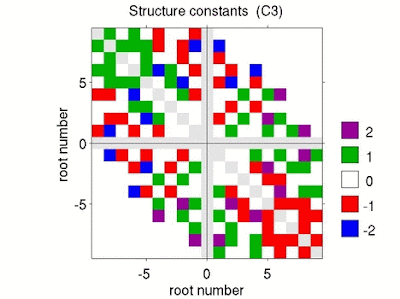Previously on Visual Lie Theory it was mentioned, that the commutator of two basis elements of a Lie algebra \(\cal{L}\) is again an element of \(\cal{L}\). I.e., it can be written as a linear combination of the basis vectors \(t_k, k=1,\ldots,d\); i.e.,
\[
[t_i, t_j] = \sum_{k=1}^d f^k_{ij}\,t_k
\] From the
literature I learn, that the parameters \(f^k_{ij}\) ("
structure constants") (almost?) completely describe the Lie algebra \(\cal{L}\).
What's interesting about the structure constants is, that once the \(f^k_{ij}\) are known, one immediately can write down a \(d\)-dimensional matrix representation of \(\cal{L}\), the
adjoint representation. Concretely, the adjoint representation of \(t_i\), the \(i\)-th generator, is given by
\[
(T_i)_{k,j} = f^k_{ij}
\] where \(j = 1,\ldots,d\) and \(k = 1,\ldots,d\) denote the row and column index of the matrix \(T_i\).
Clearly, the structure constants depend on the chosen basis vectors \(t_k, k=1,\ldots,d\). Viewed from another basis \[
t_k \rightarrow \tilde{t}_k \equiv \sum_{l=1}^d a^l_k\,t_l
\] the structure constants will change as well;
\[
[\tilde{t}_i, \tilde{t}_j] = \sum_{k=1}^d \tilde{f}^k_{ij}\,\tilde{t}_k
\] It turns out, that there is a particular basis, known as the
Chevalley basis, in which the \(f^k_{ij}\) are integers and assume only values between \(-3\) and \(+3\); in addition, the sum in \[
[t_i, t_j] = \sum_{k=1}^d f^k_{ij}\,t_k
\] contains at most one non-zero element.
In general, the generators \(t_i, i=1,\ldots,d\) can be divided in \(d-r\) generators \(e_\alpha\) corresponding to non-zero roots and \(r\) generators \(h_\alpha\) corresponding to zero roots; \(d\) being the dimension and \(r\) being the rank of \(\cal{L}\). Here, the label \(i\) of the generator \(t_i\) is replaced by the root \(\alpha\), which we may regard as a \(r\)-dimensional index of \(e_\alpha\) and \(h_\alpha\). For the generators \(e_\alpha\) we find
\[
[e_{\alpha_i}, e_{\alpha_j}] = K_{ij}\,e_{\alpha_i+\alpha_j}
\] where \(K_{ij}\) is non-zero if the sum \(\alpha_i+\alpha_j\) is a non-zero root. If \(\alpha_i+\alpha_j\) is not a root, the commutator vanishes (\(K_{ij}=0\)). If \(\alpha_i+\alpha_j\) is a zero-root (i.e. \(\alpha_j = -\alpha_i\)) the commutator is
\[
[e_{\alpha_i}, e_{-\alpha_i}] = h_{\alpha_i}
\] where \(h_{\alpha_i}\) is an element of the Cartan subalgebra. All generators contained within the Cartan subalgebra commute, i.e.
\[
[h_{\alpha_i}, h_{\alpha_j}] = 0
\]. Furthermore,
\[
[h_{\alpha_i}, e_{\alpha_j}] = N_{ij}\,e_{\alpha_j}
\] with \(N_{ij}\) being the entries of the
Cartan matrix.
Since all information on \(\cal{L}\) supposedly is encoded in the
\(f^k_{ij}\), naively I had expected that there existed tables of
\(f^k_{ij}\) (or \(K_{ij}\)) for all (classical and exceptional) Lie algebras. My web search, however, turned up surprisingly little -
perhaps I looked at all the wrong places.
So how does
one (or a computer) then actually calculate the \(f^k_{ij}\)? The following
two papers I found most useful for finding an answer :
- V. K. Agrawala and Johan G. Belinfante: Weight diagrams for lie
group representations: A computer implementation of Freudenthal's
algorithm in ALGOL and FORTRAN, BIT (1969) 9(4):301-314. doi: 10.1007/BF01935862
- R.B Howlett, L.J Rylands, D.E Taylor: Matrix Generators for
Exceptional Groups of Lie Type, Journal of Symbolic Computation, volume
31, issue 4, April 2001, pages 429-445, doi: 10.1006/jsco.2000.0431
Based on algorithms and source code contained therein I wrote some
MATLAB programs (the only computer language I speak somewhat fluently) for the calculation of the coefficients \(K_{ij}\); these tools ("LieTools") are available for download
here. (At this point
Octave is not (yet) supported due to Octave's missing implementation of nested functions.)
 |
| Fig. 1: Structure constants \(K_{ij}\) for the Lie algebra F4 (52 dimensions, i.e. 52-4=48 non-zero roots) |
As an example figure 1 shows a graphical representation of (what "LieTools" thinks are) the coefficients \(K_{ij}\) for the exceptional Lie algebra F4. In the Chevalley basis the \(K_{ij}\) assume one of five possible value, \(-2,-1,0,+1,+2\), here plotted in 5 different colours. (You've probably noticed that I used part of this figure for the blog header.)








